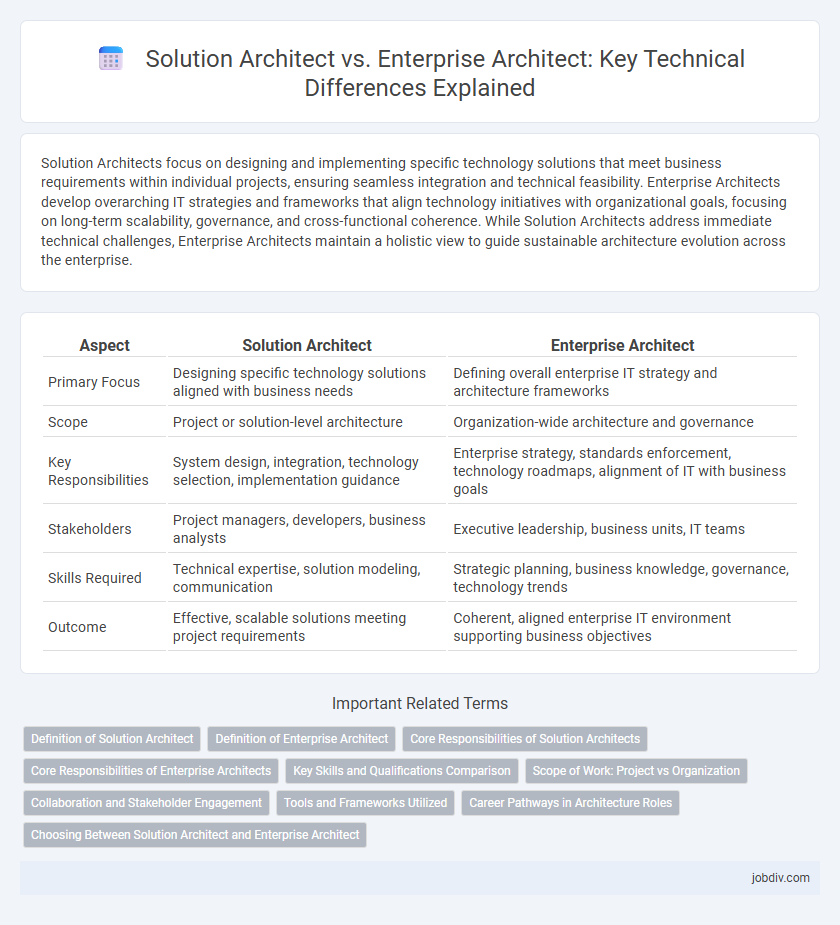Solution Architects focus on designing and implementing specific technology solutions that meet business requirements within individual projects, ensuring seamless integration and technical feasibility. Enterprise Architects develop overarching IT strategies and frameworks that align technology initiatives with organizational goals, focusing on long-term scalability, governance, and cross-functional coherence. While Solution Architects address immediate technical challenges, Enterprise Architects maintain a holistic view to guide sustainable architecture evolution across the enterprise.
Table of Comparison
| Aspect | Solution Architect | Enterprise Architect |
|---|---|---|
| Primary Focus | Designing specific technology solutions aligned with business needs | Defining overall enterprise IT strategy and architecture frameworks |
| Scope | Project or solution-level architecture | Organization-wide architecture and governance |
| Key Responsibilities | System design, integration, technology selection, implementation guidance | Enterprise strategy, standards enforcement, technology roadmaps, alignment of IT with business goals |
| Stakeholders | Project managers, developers, business analysts | Executive leadership, business units, IT teams |
| Skills Required | Technical expertise, solution modeling, communication | Strategic planning, business knowledge, governance, technology trends |
| Outcome | Effective, scalable solutions meeting project requirements | Coherent, aligned enterprise IT environment supporting business objectives |
Definition of Solution Architect
A Solution Architect designs and implements specific technology solutions addressing business needs by bridging the gap between enterprise strategy and project execution. They focus on creating detailed architecture for software applications, systems integration, and infrastructure components to ensure scalability, security, and performance. Their role involves collaborating with stakeholders, developers, and business analysts to translate requirements into technical specifications aligned with organizational goals.
Definition of Enterprise Architect
Enterprise Architect defines the overarching IT strategy and aligns technology initiatives with business goals across the entire organization. This role involves creating comprehensive frameworks that ensure consistency, scalability, and governance of IT assets and processes. Enterprise Architects coordinate cross-functional technology standards to drive digital transformation and optimize enterprise-wide architecture.
Core Responsibilities of Solution Architects
Solution Architects specialize in designing and implementing specific IT solutions that align with business requirements, ensuring seamless integration with existing systems. Their core responsibilities include defining system architecture, selecting appropriate technologies, and overseeing the development process to guarantee technical feasibility and performance. They act as a bridge between stakeholders and development teams, translating business needs into detailed technical specifications to deliver scalable and efficient solutions.
Core Responsibilities of Enterprise Architects
Enterprise Architects oversee the alignment of IT strategies with business goals, ensuring that technology frameworks support scalable and sustainable enterprise growth. They define enterprise-wide architectural standards, governance policies, and oversee integration across various business units to optimize performance and compliance. Their core responsibilities include strategic planning, stakeholder collaboration, and maintaining a holistic view of business processes, applications, data, and infrastructure to drive innovation and operational efficiency.
Key Skills and Qualifications Comparison
Solution Architects excel in designing specific technology solutions, requiring deep expertise in system design, application architecture, and software development frameworks. Enterprise Architects possess broad strategic skills including IT governance, business process modeling, and enterprise-wide technology integration, emphasizing alignment with organizational objectives. Both roles require strong communication abilities, but Solution Architects focus on technical implementation skills, whereas Enterprise Architects prioritize business strategy and comprehensive IT ecosystem understanding.
Scope of Work: Project vs Organization
Solution Architects concentrate on designing and implementing specific project-level solutions, ensuring technical requirements align with business needs and system integration. Enterprise Architects oversee the entire organizational architecture, developing long-term strategies that align IT infrastructure, processes, and goals across multiple projects and departments. Their scope encompasses cross-functional coordination and governance to drive enterprise-wide transformation and scalability.
Collaboration and Stakeholder Engagement
Solution Architects collaborate closely with project teams and technical stakeholders to design specific system solutions that align with business requirements. Enterprise Architects engage with a broader range of stakeholders, including business executives and IT leadership, to ensure architectural coherence across the entire organization. Both roles emphasize stakeholder engagement but differ in scope, with Solution Architects focusing on project-level collaboration and Enterprise Architects on enterprise-wide alignment.
Tools and Frameworks Utilized
Solution Architects primarily utilize tools such as UML modeling software, enterprise architecture frameworks like TOGAF, and DevOps platforms to design specific system solutions aligned with business needs. Enterprise Architects leverage broader frameworks including Zachman and ArchiMate, alongside comprehensive governance tools to ensure organizational IT alignment and strategy coherence. Both roles integrate collaborative platforms like Jira and Confluence to facilitate seamless communication throughout project lifecycles.
Career Pathways in Architecture Roles
Solution Architects focus on designing and implementing specific technology solutions that align with business needs, mastering tools like cloud platforms and application frameworks. Enterprise Architects oversee the broader IT strategy and governance, integrating diverse systems and ensuring alignment with organizational goals across departments. Career pathways often start with roles such as Software Developer or Systems Analyst for Solution Architects, while Enterprise Architects typically advance from IT management or business analysis positions, emphasizing strategic planning and cross-functional leadership skills.
Choosing Between Solution Architect and Enterprise Architect
Choosing between a Solution Architect and an Enterprise Architect depends on the scope and impact of the project; Solution Architects focus on designing specific technology solutions aligned with business needs, while Enterprise Architects develop overarching IT strategies to support long-term organizational goals. Solution Architects prioritize application architecture, integration, and technical delivery, whereas Enterprise Architects oversee enterprise-wide frameworks, governance, and alignment of IT portfolio with business strategy. Organizations benefit from selecting Solution Architects for tactical project execution and Enterprise Architects for strategic planning and cross-functional technology alignment.
Solution Architect vs Enterprise Architect Infographic

 jobdiv.com
jobdiv.com